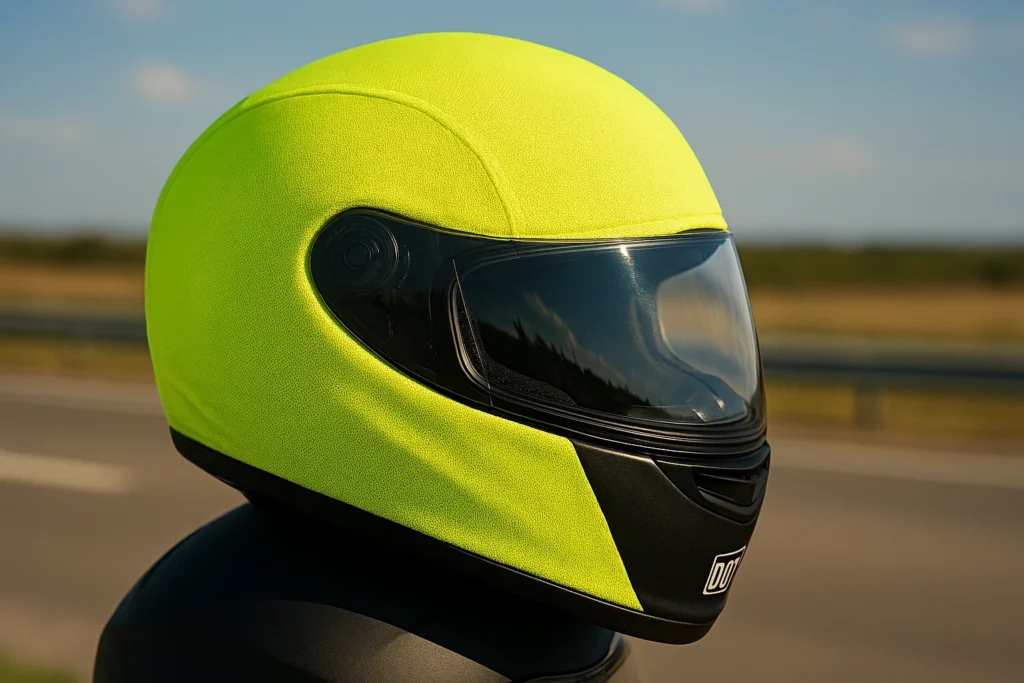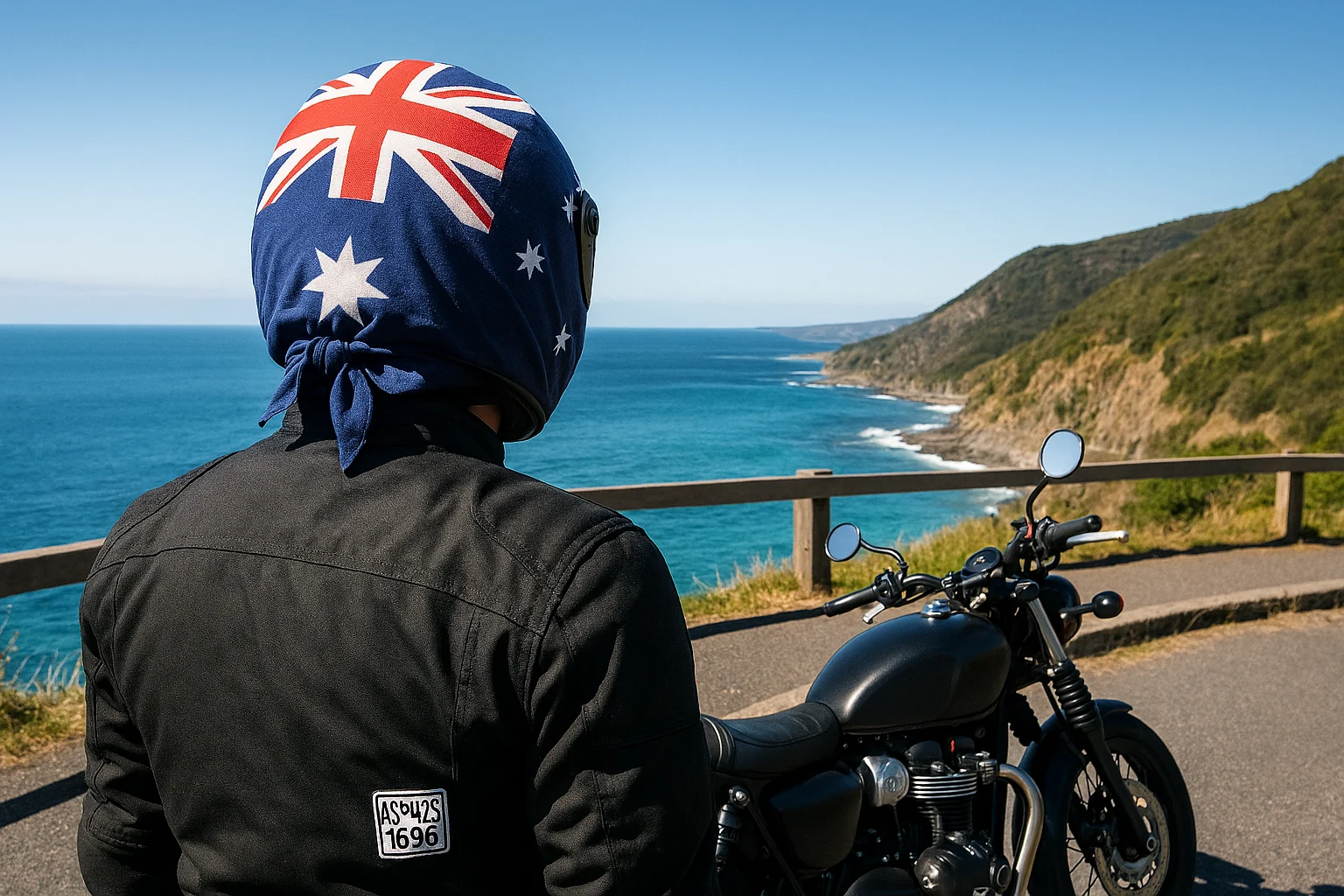These covers come in all sorts of designs: camo, neon colors, animal heads, and even superhero themes. They not only look cool but also protect the helmet shell from scratches and scuffs. The big question I asked myself before I bought my first one was: Are Motorcycle Helmet Covers Legal?
If you ride motorcycles as much as I do, you know that our helmets are more than just safety gear. They are part of our identity. Over the years, I have tried many ways to make my helmet stand out, from bright stickers to reflective tape. But one thing I have really enjoyed experimenting with is cloth motorcycle helmet covers.
The answer is not straightforward, and that is exactly what I am going to break down for you in this guide. Curious about modern helmet upgrades? Discover whether motorcycle helmets have Bluetooth so you can stay connected safely while riding.
Why I Started Using Cloth Motorcycle Helmet Covers
When I first started riding, I only cared about the helmet meeting safety standards. But after a few years, I wanted to make my gear more personal. My plain matte-black helmet was good for safety but not very exciting to look at.
I first noticed motorcycle helmet covers at a bike meet. One rider had a tiger-head cover that made his helmet look wild. Another had a neon yellow one that was almost impossible to miss in traffic.

For me, the first reason to try a cloth motorcycle helmet cover was protection. Helmets are expensive, and I wanted to keep mine looking new for as long as possible. The second reason was visibility. As a biker, I know how important it is for other drivers to see me. Bright covers stand out more than dark helmets, especially in bad weather.
Are Motorcycle Helmet Covers Legal: Understanding Motorcycle Helmet Laws
Before I bought my first cover, I had to learn how helmet cover laws work. In most countries, the law focuses on whether your helmet meets safety certifications, not what it looks like.
Here are the most common helmet safety standards:
- DOT (Department of Transportation) – Mandatory for helmets sold in the United States.
- ECE (Economic Commission for Europe) – Common in Europe and many other countries.
- Snell Certification – A stricter voluntary standard in the US.
- ISI (Indian Standards Institute) – Mandatory in India.
- AS/NZS – Australian and New Zealand certification standard.
The key point is that the law requires the helmet to meet one of these safety standards. The helmet must also display the certification sticker. Find out if Ruroc is a good brand when you’re sizing up high-performance helmet options.
When Cloth Motorcycle Helmet Covers Might Be a Problem
A cloth motorcycle helmet cover by itself does not make a helmet illegal. But it can become a problem if it affects safety or hides required labels. Here’s what I found out from my research and experience:
- Blocking Visibility: If a cover blocks your side vision or even slightly restricts your ability to turn your head and see, it can be considered unsafe.
- Hiding Safety Stickers: In many places, it is illegal to cover the DOT, ECE, or ISI sticker. Police officers might pull you over if they cannot see it.
- Changing Helmet Performance: Some novelty covers with spikes, ears, or large shapes can change the aerodynamics of the helmet. At high speeds, this can cause wind drag and neck strain.
- Law Enforcement Attention: Even if a cover is not technically illegal, unusual designs can still draw attention from police. If they think it affects your safety, they can stop you.
Helmet Cover Laws in Different Countries
Here is what I learned when checking helmet laws across different regions.
United States
Helmet laws vary from state to state. Most states require DOT-approved helmets, but they do not specifically mention cloth motorcycle helmet covers. If the cover hides the DOT sticker or reflective elements, you might get fined. Novelty covers with big ears or spikes are more likely to get noticed by law enforcement.
United Kingdom and Europe
Helmets must meet ECE standards. Helmet covers are allowed, as long as they do not affect visibility or safety. You must keep reflective stickers uncovered.
Australia and New Zealand
Helmets must meet AS/NZS standards. It is legal to use a helmet cover, but you cannot cover the certification label.
India
ISI-certified helmets are required. There is no law specifically banning motorcycle helmet covers, but police can fine you if the cover blocks visibility or hides the ISI mark.
My First Ride With a Cloth Motorcycle Helmet Cover
When I got my first helmet cover, a bright neon yellow one, I felt more visible on the road right away. I could see drivers noticing me earlier, especially in heavy traffic. It felt like having a built-in safety feature.
However, I learned a few lessons:
- On windy days, some covers can flap slightly, which is distracting.
- A thick cover can reduce airflow, making hot weather rides uncomfortable.
- At fuel stops, a few curious people came over to ask about it, which was a fun way to start conversations with other bikers.
Benefits of Using Motorcycle Helmet Covers
From my experience, here are the biggest advantages of cloth motorcycle helmet covers:
- Protection from Scratches: Keeps the helmet looking newer for longer.
- Better Visibility: Bright covers make it easier for cars to see you, reducing accident risk.
- Style and Personalization: Lets you express your personality without buying a whole new helmet.
- Easy to Change: You can swap covers depending on your mood or the occasion.
Learn whether Ruroc helmets are safe and what makes them stand out in terms of protection.
Risks and Downsides
Not everything about helmet covers is perfect. Here are the risks I keep in mind:
- Wind Resistance: Some novelty designs create drag at higher speeds.
- Reduced Airflow: Thick material can block ventilation holes.
- Potential Fines: If the cover hides certification stickers, you could get stopped by police.
How to Use Cloth Motorcycle Helmet Covers Safely and Legally
If you decide to try one, here are my personal safety rules:
- Keep Certification Stickers Visible: Never cover your DOT, ECE, or other safety labels.
- Choose Bright Colors for Visibility: Neon or reflective designs are not just for style, they help keep you safe.
- Avoid Large Attachments: Skip covers with big ears, spikes, or anything that sticks out too far.
- Check Local Laws: A quick Google search for “are helmet covers legal in [your state or country]” can save you trouble.
- Test at Low Speed First: Try riding with the cover in a parking lot before taking it on the highway.
Real-Life Scenarios Where Motorcycle Helmet Covers Can Make a Difference
When I first started using motorcycle helmet covers, I didn’t realize how useful they could be beyond just style. Over time, I noted that certain riding situations made the cover more than just a fashion choice, it became a functional piece of gear.
1. Riding in Heavy Traffic
If you’ve ever ridden through a city during rush hour, you know how dangerous it can be when drivers are distracted. I’ve found that wearing a bright neon or reflective cloth motorcycle helmet cover makes me stand out more in a sea of gray and black cars. This extra visibility has, in my opinion, reduced the number of “close calls” I’ve had. Even if helmet cover laws are strict in your area, choosing one that is road-safe and sticker-friendly can give you that visibility advantage without breaking the rules.
2. Group Rides
On group rides, motorcycle helmet covers can help riders keep track of each other. I once went on a charity ride with over 100 bikers. i would a bright orange cover, and my friends could easy spot me even from a few hundred meters away. This is a small but powerful way to keep the group together. Plus, unique covers make for great group photos.
3. Long-Distance Touring
If you go on multi-day trips, your helmet takes a beating from sun, wind, and dust. I learned the hard way that UV rays can fade the paint and graphics on your helmet. A cloth motorcycle helmet cover acts as a shield, keeping the shell in better condition. This is especially important if you have an expansive helmet that you want to keep looking good for years.
4. Rainy Weather
I ride in all conditions, and I noted that certain helmet covers help with water runoff. Some covers are made from water-resistant fabric, which keeps rain from pooling around the vents. This isn’t a substitute for proper rain gear, but it can add a small layer of comfort on wet days.
5. Seasonal and Themed Rides
Motorcycle events often have themed rides, like Halloween runs or Christmas charity rides. Helmet covers in the shape of pumpkins, Santa hats, or reindeer heads can make the ride more fun. As long as they follow helmet cover laws by leaving safety stickers visible and not blocking vision, they are usually fine.
Extra Pro Tips for Using Helmet Covers
Here’s what I’ve learned after years of using theme:
- Rotate Between Covers: Having multiple covers lets you match the design to the weather or event.
- Wash Regularly: A dirty cover can hold dust, which might scratch the helmet over time.
- Check Fit Before Riding: If the cover is loose, it could slip during the ride, which is dangerous.
- Avoid Blocking Reflectors: Some helmets have built-in reflective strips that are part of their safety design, never cover these.
In the end, motorcycle helmet covers can be more than just a fashion accessory. Used wisely, they can improve safety, visibility, and helmet lifespan while still keeping you within the law. The trick is to know your helmet cover laws, pick the right material, and make sure it doesn’t interfere with your riding experience.
Are Helmet Covers Worth It for Bikers?
In my opinion, yes, if you choose the right one and follow the rules. As a rider, anything that improves my visibility and protects my gear is worth considering.
For daily commuting, I prefer a bright safety color. For weekend rides with friends, I might switch to a fun design just for laughs. The beauty of cloth motorcycle helmet covers is that you can change them anytime.
Final Thoughts
So, are motorcycle helmet covers legal? In most places, yes, as long as they do not block safety stickers, reduce your vision, or change how the helmet protects your head.
For me, they have been a great mix of safety, style, and practicality. The key is to pick a cover that works with your riding style and meets your local helmet cover laws. Make sure you’re on the right side of the law, read about are Bluetooth motorcycle helmets legal before you hit the road.
If you are a biker who wants to personalize your gear while staying safe and legal, a cloth motorcycle helmet cover might be the perfect accessory for you. Just remember: safety first, style second.





